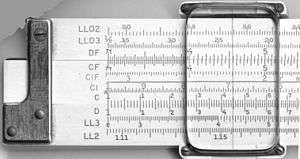Graduation (instrument)
Graduation is the marking of an instrument with indicators of a measurement.
Linear graduation

Linear graduation of a scale occurs on a straight instrument. The graduation can identify linear measures, such as inches or millimetres on a rule. They can also be non-linear such as logarithmic or other transcendental scales. Volumetric graduations, for instance on a measuring cup, can vary in scale due to the container's conical or abstract shape.
Curved graduations
Circular graduations of a scale occur on a circular arc or limb of an instrument. In some cases, non-circular curves are graduated in instruments. A typical circular arc graduation is the division into angular measurements, such as degrees, minutes and seconds. There can also be non-uniform graduations such as logarithmic or other scales.
Manufacture of graduations
Graduations can be placed on an instrument by etching, scribing or engraving, painting, printing or other means. For durability and accuracy, etched or scribed marks are usually preferable to surface coatings such as paints and inks. Markings can be a combination of both physical marks such as a scribed line and a paint or other marking material. For example, it is common for black ink or paint to fill the grooves cut in a scribed rule. Inexpensive plastic devices can be molded and painted or molded with two or more colours of plastic used. Some rather high-quality devices can be manufactured with plastic and reveal high-precision graduations.
Graduations traditionally have been scribed into an instrument by hand with a sharp, hard tool.[1] Later developments in devices such as dividing engines allowed the process to automated with greater precision. Modern devices can be stamped, cut on a milling machine or with a CNC machine. In the case of stamping, the master has the precision built into itself and the stamped device is as accurate as the stamping process allows. Similarly, molding of plastic can be as precise as the mold process. With proper concern for such effects as thermal expansion or contraction and shrinkage, the precision can be very high.
See also
References
- ↑ Daumas, Maurice, Scientific Instruments of the Seventeenth and Eighteenth Centuries and Their Makers, Portman Books, London 1989 ISBN 978-0-7134-0727-3